| Rating | Image | Address | Year | Form | Style | Comments |
|---|
| Contributing |  | 357 Ashley Ave. | 1921 | Foursquare | | |
|---|
| Contributing |  | 360 Ashley Ave. | 1919 | Foursquare | | |
|---|
| Non-contributing |  | 361 Ashley Ave. | 1919 | Lateral-gable | | Brick veneer added before district created; original windows torn out after district created |
| Contributing |  | 362 Ashley Ave. | 1919 | Front-gable | | Twin to 4 Elmwood Ave. and 551 Huger St. |
|---|
| Contributing |  | 364 Ashley Ave. | 1922 | Foursquare | | |
|---|
| Contributing |  | 366 Ashley Ave. | 1919 | Bungalow | | |
|---|
| Contributing |  | 368 Ashley Ave. | 1920 | Front-gable | | |
|---|
| Contributing |  | 369 Ashley Ave. | 1919 | Front-gable | | Mirror twin to 324 President St. |
|---|
| Contributing |  | 176 Congress St. | 1919 | Foursquare | | |
|---|
| Contributing |  | 180 Congress St. | 1919 | Foursquare | | |
|---|
| Contributing |  | 182 Congress St. | 1920 | Foursquare | | Near twin to 475 Huger St., 494 Huger St., and 625 Rutledge Ave. |
|---|
| Contributing |  | 184 Congress St. | 1920 | Foursquare | | |
| Contributing |  | 188 Congress St. | 1921 | Bungalow | | |
| Contributing |  | 204 Congress St. | 1922 | Foursquare variant | | |
| Contributing |  | 212 Congress St. | 1921 | Foursquare | | |
| Contributing |  | 216 Congress St. | 1921 | Bungalow | | Shown here in January 2007, the original, red brick exterior was painted in 2008:
 |
| Contributing |  | 218 Congress St. | 1917 | Foursquare | | |
| Contributing |  | 220 Congress St. | 1917 | Front-gable | | |
| Contributing |  | 230 Congress St. | 1920 | Foursquare | | |
| Contributing |  | 232 Congress St. | 1920 | Front-gable | | Built by George Trescott; twin to 236 Congress St., 1 South Allan Park, 5 South Allan Park, 368 Ashley Ave., and 299 President St. |
| Contributing |  | 236 Congress St. | 1920 | Front-gable | | Built by George Trescott; twin to 232 Congress St., 1 South Allan Park, 5 South Allan Park, 368 Ashley Ave., and 299 President St. |
| Contributing |  | 238 Congress St. | 1920 | Front-gable | | |
| Non-contributing |  | 247 Congress St. | 1930 | Corner store | | Harold's Cabin Grocery |
| Non-contributing |  | 249 Congress St. | 1910 | Charleston single house | | |
| Contributing |  | 248 Congress St. | 1919 | Lateral-gable | Craftsman influence | |
| Contributing |  | 251 Congress St. | 1936 | Bungalow influence | | Built for Marion H. Drews (Chas. Building Permit #3032) |
| Contributing |  | 252 Congress St. | 1931 | Other | Minimal traditional | |
| Contributing |  | 253 Congress St. | 1930 | Foursquare | | |
| Contributing |  | 254 Congress St. | 1931 | Other | Minimal traditional | Shown here in 2007 before its original windows were torn out:
 |
| Contributing |  | 255 Congress St. | 1925 | Front-gable | | |
| Contributing |  | 257 Congress St. | 1926 | Foursquare | | |
| Contributing |  | 258 Congress St. | 1921 | Lateral-gable | | |
| Contributing |  | 270 Congress St. | 1915 [8] | Front-gable | | An example of a Sears catalog house known as "The Roanoke" |
| Contributing |  | 274 Congress St. | 1920 | Foursquare | | |
| Contributing |  | 276 Congress St. | 1919 | Bungalow | | |
| Non-contributing |  | 278 Congress St. | 2009 | Front-gable | | The property was a vacant lot before the house was built. |
| Contributing |  | 286 Congress St. | 1915 [9] | Front-gable | | |
| Contributing |  | 288 Congress St. | 1915 [10] | Bungalow | | |
| Contributing |  | 292 Congress St. | 1922 | Bungalow influence | | |
| Contributing |  | 294 Congress St. | 1915 [11] | Bungalow | Queen Anne influence | |
|---|
| Contributing |  | 296 Congress St. | 1931 | Bungalow influence | | |
| Contributing |  | 304 Congress St. | 1919 | Front-gable | | |
| Contributing |  | 306 Congress St. | 1916 | Front-gable | | |
| Contributing |  | 310 Congress St. | 1920 | Foursquare | | |
| Contributing |  | 312 Congress St. | 1920 | Foursquare | | The original one-story porch had a deck added in about 2010. |
| Contributing |  | 314 Congress St. | 1923 | Foursquare variant | | |
| Non-contributing |  | 1 Elmwood Ave. | 1920 | Foursquare | | Added brick veneer |
| Contributing |  | 2 Elmwood Ave. | 1916 | Foursquare | | |
|---|
| Contributing |  | 3 Elmwood Ave. | 1915 | Foursquare | | |
|---|
| Contributing |  | 4 Elmwood Ave. | 1920 | Front-gable | | Twin to 362 Ashley Ave. and 551 Huger St.; subsequent renovation reopened porch but removed original windows |
|---|
| Contributing |  | 5 Elmwood Ave. | 1916 | Bungalow | | Twin of 17 Kenilworth Ave. and 341 President St. |
|---|
| Contributing |  | 6 Elmwood Ave. | 1914 [12] | Bungalow | | Before being restored in 2013, the house (shown here in 2011) was covered in vinyl siding:
 |
|---|
| Contributing |  | 7 Elmwood Ave. | 1917 | Bungalow | Craftsman | |
|---|
| Contributing |  | 8 Elmwood Ave. | 1917 | Front-gable | | A second floor was added to the front porch in 2012. |
|---|
| Contributing |  | 9 Elmwood Ave. | 1915 | Front-gable | | |
|---|
| Contributing |  | 10 Elmwood Ave. | 1917 | Foursquare | | Home of U.S. Representatives Thomas S. McMillan and Clara G. McMillan from 1917 to 1922 |
|---|
| Non-contributing |  | 13 Elmwood Ave. | 1916 | Lateral-gable | | |
| Contributing |  | 14 Elmwood Ave. | 1916 | Lateral-gable | | |
|---|
| Contributing | 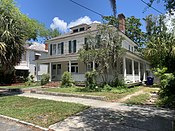 | 16 Elmwood Ave. | 1915 | Foursquare | | |
|---|
| Contributing |  | 18 Elmwood Ave. | 1922 | Foursquare | | |
|---|
| Contributing |  | 1 Glenwood Ave. | 1919 | Foursquare | | |
|---|
| Contributing |  | 3 Glenwood Ave. | 1917 | Foursquare | | |
|---|
| Contributing |  | 4 Glenwood Ave. | 1921 | Lateral-gable | | |
|---|
| Contributing |  | 5 Glenwood Ave. | 1916 | Foursquare | | Twin to 331 President St. |
|---|
| Contributing |  | 7 Glenwood Ave. | 1919 | Front-gable | | |
|---|
| Contributing |  | 9 Glenwood Ave. | 1916 | Foursquare | | |
|---|
| Contributing |  | 74 Hagood Ave. | 1938 | Lateral-gable | Colonial Revival influence | |
|---|
| Non-contributing |  | 76 Hagood Ave. | 1922 | Bungalow | | Twin to 78 Hagood Ave.; alterations and brick veneer added |
| Contributing |  | 78 Hagood Ave. | 1922 | Bungalow | | |
|---|
| Contributing |  | 80 Hagood Ave. | 1917 | Bungalow | | |
|---|
| Non-contributing |  | 427 Huger St. | 2022 | Contemporary | | |
|---|
| Contributing |  | 429 Huger St. | 1913 | Foursquare | | |
|---|
| Contributing |  | 439 Huger St. | 1922 | Front-gable | | |
|---|
| Contributing |  | 441 Huger St. | 1914 | Front-gable with Queen Anne influence | | |
|---|
| Contributing |  | 443 Huger St. | 1913 | Foursquare | | Shown here in 2012 just before its vinyl siding was removed during a restoration:
 |
|---|
| Contributing |  | 447 Huger St. | 1921 | Foursquare | | |
|---|
| Contributing |  | 451 Huger St. | 1920 | Foursquare variant | | |
|---|
| Contributing |  | 460 Huger St. | 1912 | Foursquare | | |
|---|
| Contributing |  | 462 Huger St. | 1912 | Bungalow influence | | |
|---|
| Contributing |  | 463 Huger St. | 1921 | Lateral-gable | Prairie | Shown here in 2003, the house received an award from the Preservation Society of Charleston for its restoration in 2011: [13]
 |
|---|
| Contributing |  | 464 Huger St. | 1923 | Foursquare | | |
|---|
| Contributing |  | 468 Huger St. | 1914 | Foursquare | | Original windows removed during subsequent remodelling |
|---|
| Non-contributing |  | 470 Huger St. | 1917 | Cottage | | |
| Contributing |  | 471 Huger St. | 1938 | Other | Tudor Revival | |
|---|
| Non-contributing |  | 472 Huger St. | 1951 | Other | Ranch | |
| Contributing |  | 473 Huger St. | 1920 | Foursquare | | |
|---|
| Contributing |  | 475 Huger St. | 1919 | Lateral-gable | | Near twin to 494 Huger St., 625 Rutledge Ave., and 182 Congress St. |
|---|
| Contributing |  | 477 Huger St. | 1915 | Foursquare | | |
|---|
| Contributing |  | 478 Huger St. | 1937 | Lateral-gable | Colonial Revival | The house was designed by its first owners, the Werles of New Jersey, using Winnsboro granite. [14] |
|---|
| Contributing |  | 489 Huger St. | 1920 | Other | Prairie | Mirror image twin to 6 Wesson Ave. |
|---|
| Non-contributing |  | 490 Huger St. | 1914-1917 | Freedman's cottage | | The house was used as a commercial structure for most of the 20th century, including as period as a dance school. [15] |
| Contributing |  | 491 Huger St. | 1920 | Bungalow | Craftsman | |
|---|
| Contributing |  | 493 Huger St. | 1917 | Foursquare | Queen Anne influence | |
|---|
| Contributing | 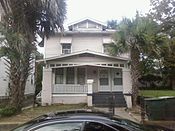 | 494 Huger St. | 1918 | Foursquare | | Built by George T. Trescott; near twin to 475 Huger St., 625 Rutledge Ave., and 182 Congress St. |
|---|
| Contributing |  | 496 Huger St. | 1915 | Front-gable | | |
|---|
| Contributing |  | 497 Huger St. | 1915 | Foursquare | Queen Anne influence | Near twin of 513 Huger St., 10 Kenilworth Ave., and 335 President St. |
|---|
| Contributing |  | 500 Huger St. | 1914 | Foursquare | Queen Anne influence | |
|---|
| Contributing |  | 501 Huger St. | 1914 | Foursquare | | Childhood home of Akim Anastopoulo. The brick column in the photo (c. 1932) marked an entrance to the neighborhood but was removed at an unknown date. |
|---|
| Contributing |  | 507 Huger St. | 1914 | Foursquare | | |
|---|
| Contributing |  | 510 Huger St. | 1917 [16] | Foursquare | | Home of Samuel Rittenberg from 1919 to 1932 |
|---|
| Contributing |  | 512 Huger St. | 1912 | Foursquare | | |
|---|
| Contributing |  | 513 Huger St. | 1914 (?) | Foursquare | | Near twin to 10 Kenilworth Ave. and 331 President St. |
|---|
| Contributing |  | 515 Huger St. | 1916 | Foursquare | | |
|---|
| Contributing |  | 517 Huger St. | 1914 [17] | Foursquare | | |
|---|
| Contributing |  | 518 Huger St. | 1912 | Foursquare | | |
|---|
| Contributing |  | 530 Huger St. | 1916 | Foursquare | Queen Anne influence | |
|---|
| Contributing | 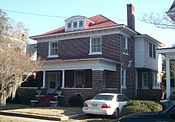 | 531 Huger St. | 1921 | Foursquare | | |
|---|
| Contributing |  | 532 Huger St. | 1919 | Lateral-gable | Prairie | Shown here in 2006, the unique, suspended roof over the front door was replaced with a much larger porch:
 |
|---|
| Contributing |  | 533 Huger St. | 1914 | Foursquare | | |
|---|
| Contributing |  | 535 Huger St. | 1939 | Bungalow influence | | |
|---|
| Non-contributing |  | 541 Huger St. | 1921 | Prairie | | |
| Contributing |  | 542 Huger St. | 1919 | Foursquare | | |
|---|
| Contributing |  | 545 Huger St. | 1915 | Foursquare | | |
|---|
| Contributing |  | 549 Huger St. | 1929 | Lateral-gable | Dutch Colonial | Aladdin house |
|---|
| Contributing |  | 548 Huger St. | 1922 | Foursquare | | |
|---|
| Contributing |  | 550 Huger St. | 1921 | Bungalow | | Mirrorimage twin of 565 Huger St. but with later front-porch enclosure |
|---|
| Contributing |  | 551 Huger St. | 1919 | Front-gable | | Twin of 362 Ashley Ave. and 4 Elmwood Ave. |
|---|
| Contributing |  | 554 Huger St. | 1921 | Foursquare | | |
|---|
| Contributing |  | 555 Huger St. | 1916 | Foursquare | | |
|---|
| Contributing |  | 565 Huger St. | 1922 | Bungalow | | Mirror-image twin of 550 Huger St. but covered in later brick-patterned siding |
|---|
| Non-contributing |  | 567 Huger St. | 1922 | Lateral-gable | Craftsman influence | Near twin of 330 President St. and 14 Kenilworth Ave. |
| Contributing |  | 573 Huger St. | 1919 | Foursquare | Craftsman influence | Home of Mayor Thomas Stoney |
|---|
| Non-contributing |  | 1 Kenilworth Ave. | 1920 | Lateral-gable | | Brick veneer added |
| Contributing |  | 3 Kenilworth Ave. | 1916 | Prairie | Prairie | |
|---|
| Contributing |  | 4 Kenilworth Ave. | 1916 | Foursquare | | |
|---|
| Contributing |  | 5 Kenilworth Ave. | 1917 | Foursquare variant | | |
|---|
| Contributing |  | 6 Kenilworth Ave. | 1915 | Foursquare variant | | |
|---|
| Contributing |  | 10 Kenilworth Ave. | 1914 [18] | Foursquare | Queen Anne influence | Near twin of 497 Huger St., 513 Huger St., and 335 President St. |
|---|
| Contributing |  | 11 Kenilworth Ave. | 1919 | Other | Bungalow influence | |
|---|
| Contributing |  | 13 Kenilworth Ave. | 1915 | Other | Bungalow influence | |
|---|
| Contributing |  | 14 Kenilworth Ave. | 1920 | Lateral-gable | Craftsman influence | Near twin to 330 President St. and 567 Huger St. |
|---|
| Contributing | 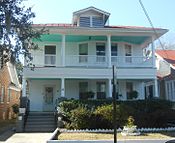 | 15 Kenilworth Ave. | 1919 | Foursquare | | |
|---|
| Contributing |  | 16 Kenilworth Ave. | 1917 | Foursquare | | |
|---|
| Contributing |  | 17 Kenilworth Ave. | 1915 | Bungalow | | Twin to 5 Elmwood Ave. and 341 President St. |
|---|
| Contributing |  | 18 Kenilworth Ave. | 1916 | Foursquare | Queen Anne influence | |
|---|
| Contributing |  | 20 Kenilworth Ave. | 1920 | Lateral-gable | Prairie influence | |
|---|
| Contributing |  | 105 Moultrie St. | 1915 [19] | Foursquare | | |
|---|
| Contributing |  | 107 Moultrie St. | 1927 | Foursquare | Craftsman influence | |
|---|
| Contributing |  | 115 Moultrie St. | 1920 | Foursquare | | |
|---|
| Contributing |  | 117 Moultrie St. | 1920 | Bungalow | Craftsman | |
|---|
| Contributing |  | 121 Moultrie St. | 1937 | Lateral-gable | Colonial Revival | Designed by Stephen Thomas for Edwin Pearlstine (Chas. building permit #3271) |
|---|
| Contributing |  | 123 Moultrie St. | 1937 | Other | Colonial Revival | Built for Milton Pearlstine (Chas. building permit #3222) |
|---|
| Non-contributing | 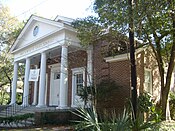 | 137 Moultrie St. | 1955 | Church | Georgian | Designed by Harold Tatum [20] |
| Non-contributing |  | 143 Moultrie St. | 1913 | Foursquare | | Brick veneer added |
| Contributing |  | 145 Moultrie St. | 1935 | Bungalow | Colonial Revival | Designed by Stephen Thomas for Mr. Isadore Solomon (Chas. building permit #1943) |
|---|
| Contributing |  | 151 Moultrie St. | 1916 | Foursquare | | Twin to 362 President St.; original windows were torn out in 1997 |
|---|
| Contributing |  | 153 Moultrie St. | 1922 | Foursquare | | |
|---|
| Contributing |  | 157 Moultrie St. | 1916 | Foursquare | | |
|---|
| Contributing |  | 161 Moultrie St. | 1914 | Foursquare | | |
|---|
| Contributing |  | 163 Moultrie St. | 1921 | Front-gable | | |
|---|
| Contributing |  | 167 Moultrie St. | 1923 | Foursquare | | |
|---|
| Contributing |  | 171 Moultrie St. | 1923 | Other | Prairie | Faculty House of The Citadel, The Military College of South Carolina; home of U.S. Representatives Thomas S. McMillan and Clara G. McMillan |
|---|
| Contributing |  | 2 North Allan Park | 1919 | Foursquare | | Shown here in 1913 before being restored:
 |
|---|
| Contributing |  | 6 North Allan Park | 1937 | Bungalow influence | | |
|---|
| Non-contributing |  | 8 North Allan Park | 1950 | Ranch | | Steel casement windows were removed on the south and west elevations following a fire. |
| Contributing |  | 4 Parkwood Ave. | 1921 | Foursquare | | Built by George Trescott; original windows were torn out in 2012 remodeling |
|---|
| Contributing |  | 6 Parkwood Ave. | 1920 | Foursquare | | |
|---|
| Contributing |  | 10 Parkwood Ave. | 1918 | Lateral-gable | Craftsman bungalow influence | |
|---|
| Contributing |  | 12 Parkwood Ave. | 1920 | Foursquare | | |
|---|
| Contributing |  | 14 Parkwood Ave. | 1917 | Foursquare | | Shown here in 1917 before a room was added above the front porch:
 |
|---|
| Non-contributing |  | 16 Parkwood Ave. | | Other | | |
| Contributing |  | 23 Parkwood Ave. | 1917 | Lateral-gable | Colonial Revival influence | |
|---|
| Contributing |  | 24 Parkwood Ave. | 1931 | Lateral-gable | Spanish Colonial | Shown here in 2004 before a renovation removed the tile roof and the decorative metalwork on the front stoop:
 |
|---|
| Contributing |  | 26 Parkwood Ave. | 1917 | Foursquare | | A room built over what had been a one-story porch, shown here in 2006, led to the collapse of the addition and the porch in 2008.
 |
|---|
| Contributing |  | 27 Parkwood Ave. | 1914 | Foursquare | | |
|---|
| Contributing |  | 29 Parkwood Ave. | 1922 | Foursquare | | |
|---|
| Contributing |  | 30 Parkwood Ave. | 1914 | Foursquare | Queen Anne influence | Shown here in 2006, the house subsequently had its original windows torn out:
 |
|---|
| Contributing |  | 31 Parkwood Ave. | 1916 | Front-gable | | Shown here before a 2010 restoration, its work was recognized with a 2012 Carolopolis Award:
 |
|---|
| Contributing |  | 32 Parkwood Ave. | 1919 | Foursquare | Queen Anne influence | Shown here in 2012 before its artificial siding was removed in 2022.:
 |
|---|
| Contributing |  | 34 Parkwood Ave. | 1917 | Front-gable | | Shown here in 1922, the house has had its porch enclosed, vinyl siding added, and windows replaced:
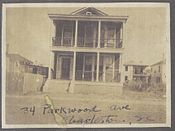 |
|---|
| Contributing |  | 35 Parkwood Ave. | 1916 | Bungalow | | |
|---|
| Contributing |  | 39 Parkwood Ave. | 1917 | Lateral-gable | Tudor Revival | |
|---|
| Non-contributing |  | 47 Parkwood Ave. | 1951 | Ranch | | Designed by Augustus Constantine |
| Contributing |  | 48 Parkwood Ave. | 1916 | Lateral-gable | Craftsman influence | |
|---|
| Contributing |  | 49 Parkwood Ave. | 1916 | Foursquare | Queen Anne influence | |
|---|
| Non-contributing |  | 52 Parkwood Ave. | 1914 | Foursquare | | |
| Contributing |  | 53 Parkwood Ave. | 1914 | Foursquare | | |
|---|
| Non-contributing |  | 54 Parkwood Ave. | 1913 | Foursquare | | |
| Contributing |  | 56 Parkwood Ave. | 1922 | Lateral-gable | | |
|---|
| Contributing | 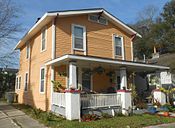 | 287 President St. | 1920 | Front-gable | | |
|---|
| Contributing |  | 291 President St. | 1919 | Bungalow | | |
|---|
| Contributing |  | 293 President St. | 1921 | Front-gable | | |
|---|
| Contributing |  | 295 President St. | 1920 | Bungalow | | |
|---|
| Contributing |  | 299 President St. | 1919 | Front-gable | | Shown here in August 2007, the house has since had its windows torn out, its eaves enclosed, and its porch columns changed:
 |
|---|
| Contributing |  | 301 President St. | 1921 | Bungalow | | |
|---|
| Contributing |  | 303 President St. | 1921 | Bungalow | | |
|---|
| Contributing |  | 305 President St. | 1925 | Bungalow influence | | |
|---|
| Contributing |  | 307 President St. | 1910 | Freedman's cottage | | |
|---|
| Contributing |  | 324 President St. | 1919 | Front-gable | | Twin to 364 Ashley Ave.; built by George Trescott; shown here before a large addition to the north (left in photo) facade in 2010:
 |
|---|
| Contributing |  | 329 President St. | 1914 [12] | Bungalow | | |
|---|
| Contributing |  | 330 President St. | 1921 | Lateral-gable | Craftsman influence | Near twin to 567 Huger St. and 14 Kenilworth Ave. |
|---|
| Contributing |  | 331 President St. | 1915 | Foursquare | | Twin to 5 Glenwood Ave. |
|---|
| Contributing |  | 332 President St. | 1917 | Foursquare | | A middle porch support was added in 2012 and the corner columns were covered. |
|---|
| Contributing |  | 335 President St. | 1913 [21] | Foursquare | | Near twin of 513 Huger St. and 10 Kenilworth Ave. |
|---|
| Contributing | 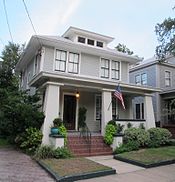 | 336 President St. | 1914 [22] | Foursquare | | |
|---|
| Contributing |  | 337 President St. | 1918 | Foursquare | | |
|---|
| Contributing |  | 338 President St. | 1917 | Foursquare | | Childhood home of Sen. Ernest F. Hollings |
|---|
| Contributing |  | 340 President St. | 1917 | Foursquare | | Shown here in April 2004, the house has since had its original windows torn out, its front porch converted into a deck, and its brickwork repointed with cement:
 |
|---|
| Contributing |  | 341 President St. | 1916 | Bungalow | | Twin to 5 Elmwood Ave. and 17 Kenilworth Ave. |
|---|
| Contributing |  | 359 President St. | 1928 | Lateral-gable | | |
|---|
| Non-contributing |  | 361 President St. | 1914 [23] | Other | | |
| Contributing |  | 362 President St. | 1916 | Foursquare | | Twin to 151 Moultrie St. until 2001 work removed some original windows and altered porch column arrangement |
|---|
| Contributing |  | 363 President St. | 1921 | Foursquare | | |
|---|
| Contributing |  | 364 President St. | 1915 [17] | Foursquare | | Home of civil rights leader Septima Clark |
|---|
| Contributing |  | 365 President St. | 1921 | Foursquare | | Built by F.J.H. Haesloop |
|---|
| Contributing |  | 367 President St. | 1914 [24] | Foursquare variant | | |
|---|
| Contributing |  | 368 President St. | 1917 | Front-gable | | Home of Claudia Tharin, founder of Florence Crittendon Home of Charleston. Before the house was restored in 2013, it had been covered in vinyl siding:
 |
|---|
| Contributing |  | 605 Rutledge Ave. | 1922 | Foursquare | | |
|---|
| Contributing |  | 607 Rutledge Ave. | 1922 | Bungalow | | |
|---|
| Contributing |  | 609 Rutledge Ave. | 1920 | Front-gable | Craftsman influence | |
|---|
| Contributing |  | 611 Rutledge Ave. | 1920 | Front-gable | | |
|---|
| Contributing |  | 619 Rutledge Ave. | 1920 | Foursquare | | |
|---|
| Contributing |  | 623 Rutledge Ave. | 1924 | Bungalow | | Original windows were later torn out. |
|---|
| Contributing |  | 625 Rutledge Ave. | 1919 | Foursquare | | Near twin to 475 Huger St., 494 Huger St., and 182 Congress St.; the house's restoration in 2012 included removing vinyl siding and restoring original windows [25] |
|---|
| Non-contributing |  | 627 Rutledge Ave. | 1990 | Commercial | | |
| Contributing |  | 1 South Allan Park | 1919 | Front-gable | | |
|---|
| Contributing |  | 3 South Allan Park | 1919 | Bungalow | | |
|---|
| Contributing |  | 5 South Allan Park | 1920 | Front-gable | | Twin to 1 South Allan Park, 232 Congress St., 236 Congress St., 368 Ashley Ave., and 299 President St. |
|---|
| Contributing |  | 444 Sumter St. | 1916 | Bungalow influence | | |
|---|
| Contributing |  | 2 Sutherland Ave. | 1916 | Lateral-gable | | |
|---|
| Non-contributing |  | 1 Sutherland Ave. | 1995 | Front-gable | | |
| Contributing |  | 3 Sutherland Ave. | 1915 | Foursquare | | Home of Mayor Thomas P. Stoney from 1915 to 1929 |
|---|
| Contributing |  | 4 Sutherland Ave. | 1917 | Front-gable | | |
|---|
| Contributing |  | 5 Sutherland Ave. | 1916 | Foursquare | | |
|---|
| Contributing |  | 6 Sutherland Ave. | 1931 | Bungalow | | |
|---|
| Contributing |  | 7 Sutherland Ave. | 1973 | | |
|---|
| Contributing |  | 8 Sutherland Ave. | 1920 | Foursquare | | |
|---|
| Contributing |  | 10 Sutherland Ave. | 1913 | Foursquare | | |
|---|
| Contributing |  | 11 Sutherland Ave. | 1913 | Front-gable | | |
|---|
| Contributing |  | 12 Sutherland Ave. | 1914 | Front-gable | Queen Anne influence | |
|---|
| Contributing |  | 14 Sutherland Ave. | 1913 | Lateral gable | Craftsman influence | Shown here in April, later in 2011, the house had its windows torn out; all its walls, ceilings, and floors removed; its chimneys removed; new openings created; its oriel window removed; and its stoop with wrought ironwork removed:
 |
|---|
| Contributing |  | 1 Sutherland Ct. | 1910 | Freedman's cottage | | |
|---|
| Non-contributing |  | 3 Sutherland Ct. | after 1942 | Other | | |
| Non-contributing |  | 5 Sutherland Ct. | 1938 | Colonial | | Shown here before brick veneer added to east (right in photo) facade and stoop enlargement:
 |
| Non-contributing |  | 6 Sutherland Ct. | 1887-1902 | Freedman's cottage | Victorian | |
| Contributing |  | 1 Wesson Ave. | 1916 | Foursquare | | |
|---|
| Contributing |  | 2 Wesson Ave. | 1920 | Foursquare | | |
|---|
| Contributing |  | 3 Wesson Ave. | 1915 | Foursquare | Queen Anne influence | |
|---|
| Contributing |  | 4 Wesson Ave. | 1917 | Foursquare | | In 2016, an unsympathetic renovation resulted in the loss of the historic house and its replacement with a new house, vaguely inspired by the original. |
|---|
| Contributing |  | 5 Wesson Ave. | 1915 | Foursquare | | |
|---|
| Contributing |  | 6 Wesson Ave. | 1920 | Other | Prairie | Mirror image twin to 489 Huger St. |
|---|
| Contributing |  | 7 Wesson Ave. | 1914 | Foursquare | | |
|---|
| Contributing |  | 8 Wesson Ave. | 1918 | Foursquare | | |
|---|
| Contributing |  | 9 Wesson Ave. | 1915 | Foursquare | | |
|---|
| Contributing |  | 10 Wesson Ave. | 1919 | Foursquare | | |
|---|
| Contributing |  | 11 Wesson Ave. | 1922 | Lateral-gable | | Built by George T. Trescott |
|---|
|

































































































































































































































































































